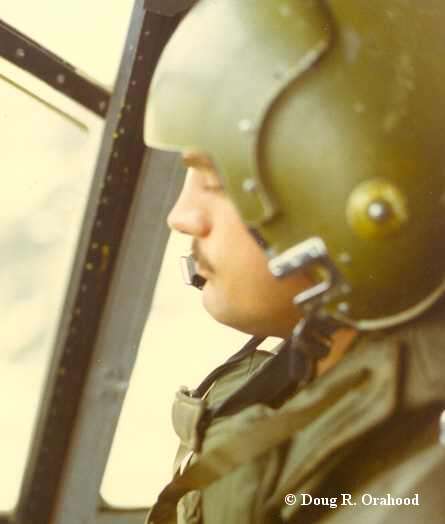 |
| All Aboard - South Vietnamese
Army soldiers board a HMM-364 Sea Knight chopper for a flight into a suspected
enemy are 28 miles south of Da Nang.
(Official U.S. Marine Corps Photo
by Cpl. Doug Woods)
|
 |
| All Aboard - South Vietnamese
Army soldiers board a HMM-364 Sea Knight chopper for a flight into a suspected
enemy are 28 miles south of Da Nang.
(Official U.S. Marine Corps Photo
by Cpl. Doug Woods)
|
Da Nang - Attack helicopters of HML-367 helped extract a Marine reconnaissance team recently by surppressing enemy fire while a CH-46 transport made the rescue. The gun ships, piloted by Capt. Dennis W. Kane (Johnstown, Pa.) and 1stLt. Robert H. Grove, Jr., (Tulsa, Okla.), were part of an emergency extract package called to rescue a small 1st Recon Bn., team surrounded by enemy forces on a hill top in Elephant Valley, 20 miles northwest of Da Nang.
When the gun ships arrived over the team, they immediately began gun runs on the enemy, expending most of their rocket, 40mmm and 7.62 mini-gun ammunition in the process. Then, with the HML-367 Cobra gun ships providing cover, an HMM-364 Sea Knight transport went in and rescued one of two wounded recon Marines by jungle penetrator before heavy enemy fire forced it out of the zone. With part of the rescue complete, he entire package refueled and rearmed at Marble Mountain Air Facility before returning to complete the extract.
When the aircraft returned to the area, two UH-1E Huey gun ships were on station keeping the enemy away from the team. They had been called in by a VMO-2 Bronco air controller, which also had Marine jets prep the area before the Cobras and the CH-46s returned.
With four gun ships providing protection, the HMM-364 Sea Knight reentered the zone and lowered a ladder to the team. Hovering until the team was safely on the ladder, the chopper spiraled out of the zone unharmed with the recon Marines clinging safely to the rescue rig.
With the Sea Knight out of the way and the zone cleared
of friendlies, Capt. Kane and 1stLt. Grove made another pass firing their
remaining ordnance as the enemy swarmed into the zone.
 Da
Nang - A Marine helicopter pilot and his crew chief teamed up to make a
daring night reconnaissance extract, 25 miles southwest of Da Nang.
First
Lieutenant David L. Cross (Pitcarin, Pa.), and Cpl. Joseph Dobosz (St.
Joseph, Mo.), of HMM-364 were flying recon missions when an emergency extract
call was received.
Da
Nang - A Marine helicopter pilot and his crew chief teamed up to make a
daring night reconnaissance extract, 25 miles southwest of Da Nang.
First
Lieutenant David L. Cross (Pitcarin, Pa.), and Cpl. Joseph Dobosz (St.
Joseph, Mo.), of HMM-364 were flying recon missions when an emergency extract
call was received.
A recon patrol had come up against an enemy force large enough to outflank them. Making their final defensive stand in a bomb crater, the surrounded Marines requested an extract.
While 1stLt. Cross was enroute to the scene, the OV-10 aircraft on station received heavy enemy fire while trying to locate the team's position and call in artillery. Once on the scene, 1stLt Cross held a quick briefing with his crew then began descending towards the zone. While maneuvering through the dark, mountainous terrain, matters became complicated when the pilot discovered he was critically low on fuel.
Continuing the mission, the pilot told the crew to drop the ladder and began backing into the zone through a small opening in the trees. At this time, the only reference Lt. Cross had to guide on was verbal instructions from Cpl. Dobosz who could see a strobe light flashed periodically by the team. While talking the pilot into the zone, Cpl. Dobosz dashed from window to window checking to ensure adequate clearance for his rotor blades.
As the chopper hovered over the extract zone, enemy automatic weapons fire opened up from a 360 degree circle. Immediately the machine gunners on the CH-46 and the accompanying Cobra gun ships began covering the area with suppressive fire, while OV-10 Bronco's dropped flares.
With the team on the ladder, Cpl. Dobosz gave Lt. Cross
the exit signal. The 30 seconds it took to clear the zone was spent
under fire from enemy guns.
Da Nang - A helicopter and it's crew is a valuable and indispensable weapon in the Vietnam war. To help insure continued success and provide suppressive fire support against the enemy, most choppers carry machine gunners.
The gunners come from a variety of occupational fields and must be trained prior to their first flight. Marine Medium Helicopter (HMM) 364, conducts a two-day school for this purpose. Marine students are first taught how to disassemble and clean the .50 caliber machine gun, their primary weapon while serving aboard a CH-46 Sea Night helicopter.
The potential gunners are then flown out over the South China Sea and instructed in techniques of shooting the weapon. Using tracers as a guide for their hits, they fire several hundred rounds through the guns at due markers in the water.
Once school is completed the gunners draw their
flight equipment and are added to the list of those eligible to fly.
Soon, the days are short of hours as the new gunners accumulate as many
as eight hours a day in the air.
Contents of this page copied from articles published in the "Sea Tiger" during September 1970.
Submitted by:
Pat Kenny, former 1stLt. USMCR
Lt. David L. Cross photo by, 1stLt.
Doug R. Orahood
Back Browser or Home
-